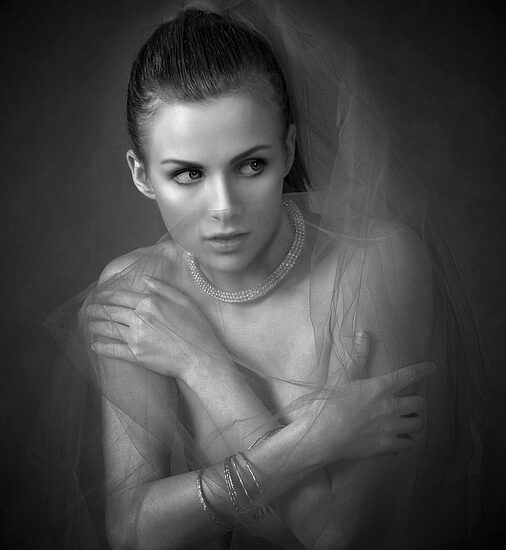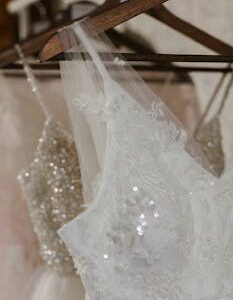As an Amazon Services LLC Associates Program participant, we earn advertising fees by linking to Amazon, at no extra cost to you.
Alternative Cleaning Methods for Bridal Veils
Explore innovative cleaning methods for bridal veils that go beyond traditional techniques.
- DIY cleaning solutions can be effective. A simple mix of vinegar and water can work wonders for spot cleaning.
- Steaming is a gentle way to remove wrinkles. It preserves the delicate lace and tulle without harsh chemicals.
- Consider professional cleaning services. They specialize in delicate fabrics and can handle significant build-up with care.
- Use breathable fabric bags for storage. This prevents yellowing and maintains the veil’s integrity over time.
- Transport your veil safely. A padded garment bag keeps it pristine during travel.
Creative Reuse Ideas for Your Bridal Veil
Most brides think their veils are just for the wedding day. I believe they can be so much more! Transforming your bridal veil into a cherished keepsake is a fantastic way to keep those memories alive.
Consider turning your veil into a lovely wall hanging. It can be framed or draped artistically in a shadow box. This way, you can admire it every day!
Another idea? Use your veil fabric to create accessories for future events. Think hairpieces for your daughter’s christening or even a decorative piece for your home. It’s that simple!
Some people suggest donating veils to organizations that support brides in need. I think this is a beautiful way to pass on the love. Your veil can help make someone else’s day special.
Most people consider traditional methods for reusing veils, but I think you should get creative! How about using the fabric for a unique table runner at your next family gathering? It adds a personal touch to any occasion.
As for those who want to keep it close, how about sewing it into a memory quilt? This transforms your veil into a cozy reminder of your special day.
According to Fabricare Center, “Spot clean small stains on bridal veils using a damp cloth or baby wipes.” This tip can help maintain your veil’s beauty for future use.
Let’s not forget about the sentimental value. Repurposing your veil can keep the spirit of your wedding alive, making it a part of your family’s story.
So, don’t just tuck your veil away! Get inspired to create something meaningful. Let your creativity shine!
Types of Tulle Fabrics and Their Uses
Tulle is a magical fabric with endless possibilities. Here are some types and their unique applications.
- Soft tulle: Perfect for delicate floral designs. It flows beautifully and adds romance to any project.
- Stiff tulle: Great for structured designs. It holds its shape well, making it ideal for skirts and overlays.
- Metallic tulle: Adds a touch of glamour. Use it for evening wear or special occasions.
- Glitter tulle: Perfect for festive looks. It sparkles and shines, making it a hit for parties.
- Cotton tulle: A breathable option. It’s comfortable and ideal for casual garments.
- Silk tulle: Luxurious and soft. It drapes elegantly, making it a favorite for bridal wear.
- Nylon tulle: Durable and versatile. It’s commonly used in costumes and tutus.
- Colored tulle: Available in various hues. It allows for creative expression in any project.
Popular Veil Styles and Their Features
Explore various veil styles to find the perfect match for your bridal look. Each style brings its unique flair, ensuring you shine on your special day.
- . Chapel Veil: This dramatic style flows elegantly to the floor, perfect for formal weddings. It adds a touch of sophistication and romance.
- . Cathedral Veil: A grand statement piece, extending beyond the train of your gown. It creates a breathtaking visual as you walk down the aisle.
- . Fingertip Veil: This versatile length reaches your fingertips, striking a balance between elegance and practicality. Ideal for both traditional and modern looks.
- . Elbow Veil: A shorter option that sits at your elbows, offering a playful vibe. Great for casual or semi-formal weddings.
- . Short Veil: Often referred to as a birdcage veil, it adds a vintage touch. Perfect for brides wanting a unique, retro look.
- . Lace-Edged Veil: Delicate lace trims elevate any veil style. It beautifully complements lace gowns, unifying your bridal ensemble.
- . Tulle Veil: Lightweight and airy, tulle veils are a classic choice. They can be layered for added volume and texture.
- . Blusher Veil: A short veil that covers the face for a romantic reveal. It’s a charming addition to any bridal look.
Essential Care for Bridal Veils
Bridal veils are delicate treasures. They deserve the utmost care to maintain their beauty. Many brides think that a simple wash will do, but I believe in gentle hand washing with mild detergents. Spot cleaning with a damp cloth works wonders for small stains, too. Professional cleaning services are a great option for significant dirt.
After cleaning, how you store your veil matters. Using breathable fabric bags or acid-free boxes can prevent yellowing. Transporting veils safely is equally important. A padded garment bag is a smart choice for travel.
Most people think traditional cleaning methods are the only way, but I think DIY solutions can be just as effective. Using a vinegar and water mix for spot cleaning is a fantastic alternative. Steaming for wrinkle removal is a game-changer, too. It preserves the fabric quality without harsh chemicals.
Many brides wonder what to do with their veils post-wedding. Creative reuse ideas can breathe new life into these cherished items. Transforming a veil into accessories for children’s christenings or home décor can keep those memories alive.
For more tips on veil care, check out the advice from the Fabricare Center, who suggest spot cleaning small stains with baby wipes. They emphasize the importance of gentle handling. Caring for your bridal veil is about preserving memories.
Tips for Choosing the Right Stabilizer in Tulle Embroidery
Here are some practical tips for selecting the best stabilizer for your tulle embroidery projects. These insights will help you achieve flawless results and enhance your creative designs.
- Use a non-woven, water-soluble stabilizer. It supports delicate tulle without leaving residue.
- Test different needle sizes. This prevents damage and ensures smooth stitching.
- Adjust your machine tension. Proper tension is key to avoiding puckering on tulle.
- Experiment with thread types. Specialty threads can add unique textures to your designs.
- Hoop carefully. Ensure the tulle is taut but not stretched to maintain its integrity.
- Conduct a test run. Always try on scrap tulle to perfect your settings before the main project.
Choosing the Perfect Veil Length and Style
Choosing a veil is like picking the cherry on top of your wedding cake. The right veil can totally transform your bridal look. From chapel to cathedral lengths, each style tells a different story.
Chapel veils are elegant and flowy, perfect for formal weddings. Cathedral veils? They bring drama and romance. Shorter veils add a playful touch, making them great for casual ceremonies.
Now, let’s talk style. Lace-edged veils can enhance your dress’s details beautifully. Tulle veils are versatile, offering a soft, ethereal look. They can complement any gown, from sleek to voluminous.
Many think traditional styles are the only way to go. But I think non-traditional options like capes or combs are worth exploring. They can incorporate tulle while adding a modern twist.
According to Pritchett Bridal, “It’s the accessory that makes you look and feel like a bride.” So, don’t shy away from experimenting!
Understanding your personal style is key. Your veil should harmonize with your dress and hairstyle. It’s all about creating a cohesive look that reflects who you are.
Let’s not forget about the historical significance of veils. They symbolize purity and tradition. Exploring this can add depth to your choice. It connects you to generations of brides before you.
The Art of Machine Embroidery on Tulle
Machine embroidery on tulle is a game changer for creating stunning designs. The delicate nature of tulle demands precision. Choosing the right stabilizer is key. I always recommend a non-woven, water-soluble stabilizer. It supports the embroidery and is easy to remove later.
Many people think metallic threads are too tricky. But I believe they add a unique flair to your designs. Just adjust your machine’s tension accordingly. Experimenting with stitch density can create a beautiful dimensional effect.
According to the BERNINA Blog, “The biggest single trick I can share for embroidery on tulle is to choose the right stabiliser.” I couldn’t agree more! Testing different needle sizes and threads is a must. This way, you ensure your tulle stays flat and beautiful.
Another approach to tulle embroidery that I love is layering embroidered elements. It gives depth and enhances the fabric’s delicate qualities. Plus, it opens up endless creative possibilities!
Understanding the different types of tulle is equally important. Soft tulle works wonders for floral designs, while stiffer varieties are perfect for structured looks. Choosing the right tulle elevates your entire project.
For more insights, check out Kat Makes, who said, “I tested one of the bernette’s built-in flower designs on a piece of scrap tulle… it worked on the first try!” See the full story here.
When a site has Accessibly App i ac-h4 installed, the website can be adjusted with keyboard navigation using the “tab” key (WCAG 2.1/2.1.1). Additionally …
Jun 11, 2021 …Tulle – see note below on how much to buy. · Matching thread · A hair comb (I like about a 3 inch comb) · Rolled hem foot (see hem options below).
When a site has Accessibly App i ac-h4 installed, the website can be adjusted with keyboard navigation using the “tab” key (WCAG 2.1/2.1.1). Additionally …
Mar 9, 2023 … I don't have a seller rec but if you want a nice, soft, flowy veil, look for English tulle veils to narrow down your Etsy search. Upvote 4
Fashion Forward: Trends in Tulle Dresses
Tulle dresses are stealing the spotlight! Their whimsical charm captivates brides and fashionistas alike. Layering tulle creates volume and drama. It’s like wearing a fairy tale.
More than just the classic white, tulle is now available in bold colors. Yes, bright reds and deep blues are making waves! This shift opens the door for personal expression.
Designers are getting creative, mixing tulle with satin and lace. This combo showcases stunning contrasts that elevate any dress. Asymmetrical cuts and detachable elements add a modern twist.
Many believe tulle is just for weddings, but I think it’s versatile. You can rock a tulle dress at parties or casual outings. It’s that simple!
According to True Society, “The lightweight and breathable nature of tulle fabric ensures that you stay comfortable throughout your special day.” Comfort and style? Count me in!
Let’s not forget about sustainability. Eco-friendly tulle options are popping up everywhere. It’s a win-win for style and the planet!
In the end, tulle dresses are more than just a trend. They represent creativity and individuality. Embrace it, and let your style shine!
As an Amazon Services LLC Associates Program participant, we earn advertising fees by linking to Amazon, at no extra cost to you.
What stabilizer should I use for tulle embroidery?
Choosing the right stabilizer for tulle embroidery is key. I believe a non-woven, water-soluble stabilizer is the best option. It supports the delicate fabric without puckering or distorting it.
Many people think any stabilizer will do, but I think that’s a mistake. Using the wrong stabilizer can ruin your design. Tulle is tricky, and it needs special care.
According to the BERNINA Blog, “The biggest single trick I can share for embroidery on tulle is to choose the right stabiliser.” This advice is spot on!
Don’t forget to test your stabilizer with different needle sizes and threads. This helps ensure your embroidery stays flat and doesn’t damage the tulle.
For those looking for alternatives, many swear by using specialty threads for unique textures. But remember, they require careful tension adjustments.
How do I safely clean my bridal veil?
Cleaning your bridal veil is a delicate process. I always recommend gentle hand washing using mild detergents. Spot cleaning with a damp cloth works wonders for small stains.
For tougher dirt, consider professional cleaning services that specialize in delicate fabrics. They know how to treat lace and tulle without damaging them.
After cleaning, store your veil in breathable fabric bags or acid-free boxes. This prevents yellowing and keeps it pristine.
Some brides even use DIY solutions like a vinegar and water mix for spot cleaning. It’s a natural method that’s gentle on fabrics.
And don’t forget about transportation! Keeping your veil flat in a sturdy box or using a padded garment bag can save it from damage.
As Fabricare Center points out, “Spot clean small stains on bridal veils using a damp cloth or baby wipes.” It’s that simple!
What are the different styles of bridal veils available?
Bridal veils come in various styles, each adding a unique touch to your look. There’s the chapel veil, which flows beautifully behind you, and the cathedral veil, perfect for dramatic entrances. Don’t forget the fingertip veil, which adds elegance without overwhelming your dress.
Short veils are playful and fun, great for casual weddings. Lace-edged veils can enhance the details of your gown, while tulle veils offer a soft, romantic vibe. Each style can transform your bridal ensemble in a stunning way.
Most people think traditional styles are the only options. But I believe exploring non-traditional choices, like capes, can bring a fresh twist. Incorporating elements of veils, such as tulle, gives a modern flair while still honoring tradition.
For more details on veil styles, check out Pritchett Bridal, where they emphasize how veils complete the bridal look.
What are the current trends in tulle dresses?
Everyone’s buzzing about tulle dresses lately! Most people think they’re just for weddings, but I see them everywhere—parties, proms, you name it. The layering trend is huge right now. It creates that dreamy, fairy-tale vibe that everyone loves.
Color is another game changer. Forget just whites and pastels! Bold hues are making a splash. I mean, who doesn’t want to stand out with a striking tulle gown?
Designers are getting creative too. Asymmetrical cuts and detachable elements are popping up. It’s like a two-for-one deal on style!
According to True Society, “The lightweight and breathable nature of tulle fabric ensures that you stay comfortable throughout your special day.” But why stop at comfort? Let’s mix in some eco-friendly fabrics. Sustainable tulle is on the rise, and it’s fabulous!
So, if you’re thinking about a tulle dress, go bold and be unique. Don’t follow the crowd; set your own trends!
Can I repurpose my wedding veil after the ceremony?
Absolutely! Repurposing your wedding veil can be a delightful way to keep the memories alive. Many brides transform their veils into unique accessories for future events, like christenings or anniversaries.
Some brides have even turned veils into home décor, like wall hangings or decorative throws. It’s all about creativity! You can cut and sew pieces of the veil into new forms, ensuring the fabric continues to bring joy.
Most people think veils are just for the wedding day, but I believe they can have a second life. Consider using them for special occasions, or even gifting them to someone special. This way, your cherished item lives on and remains meaningful.
According to Kat Makes, “I tested one of the bernette’s built-in flower designs on a piece of scrap tulle… it worked on the first try!” This shows how versatile tulle can be, even after the wedding!
So, don’t just tuck your veil away; give it a new purpose! You’ll be amazed at what you can create.
Machine embroidery on tulle? It’s a total game changer! I love how it creates stunning, delicate patterns that just pop. Using the right stabilizer is key; a non-woven, water-soluble one works wonders.
Many believe that sticking to traditional threads is best. But I think experimenting with metallic or specialty threads can really elevate the design! Just adjust your tension and watch the magic happen.
According to the BERNINA Blog, choosing the right stabilizer is crucial. I totally agree! It makes all the difference in achieving a flat finish.
Oh, and don’t forget to test different needle sizes! It’s that simple, yet so effective. The right needle can keep your tulle looking flawless.
For those looking to get creative, layering embroidered elements can add depth. It’s a fun way to play with texture!
Plus, understanding the types of tulle available can really enhance your project. Soft tulle is fantastic for floral designs, while stiffer tulle holds its shape beautifully for structured pieces.
Cleaning bridal veils isn’t just a chore; it’s an art! Most people think that tossing their veil in the washing machine is fine. But I say, gentle hand washing with mild detergents is the way to go. It keeps the delicate lace and tulle intact.
Spot cleaning small stains with a damp cloth can work wonders too. According to Fabricare Center, using baby wipes is a simple trick for those little mishaps.
And when it comes to storage, breathable fabric bags are a must! They prevent yellowing and keep your veil looking fresh for years. I believe in treating my veil like a precious heirloom, not just an accessory.
Choosing the right veil length can totally transform your bridal style. A cathedral veil creates a stunning, dramatic effect, perfect for formal weddings. Meanwhile, a fingertip length adds a playful touch and complements shorter dresses.
Many think longer veils are always better, but I believe that shorter styles can be just as impactful. They allow for more movement and comfort, especially during the reception. Plus, they can showcase intricate hairstyles beautifully!
Experimenting with different lengths lets you express your unique personality on your big day. Don’t shy away from mixing styles, like pairing a short veil with a long gown for an unexpected twist.
For more insights on bridal veils, check out Pritchett Bridal, where they emphasize that “It’s the accessory that makes you look and feel like a bride.”
Most people think tulle dresses are just for brides. I believe they are becoming a fashion staple for everyone. Designers are layering tulle to create stunning volume and texture.
It’s that simple! Mixing tulle with other fabrics like satin makes for unique styles. Colorful tulle is trending, moving away from traditional whites.
According to True Society, “The lightweight and breathable nature of tulle fabric ensures that you stay comfortable throughout your special day.” This versatility opens up endless possibilities for personal expression.
People often overlook sustainable options in tulle fashion. I think eco-friendly tulle, made from recycled materials, is the future. It’s stylish and responsible!
Repurposing your bridal veil? Yes, please! Many brides toss their veils aside after the big day, but that’s a missed opportunity.
Transforming your veil into a special keepsake, like a decorative piece or an accessory for future events, keeps those memories alive. It’s that simple!
Most people think veils are just for weddings, but I believe they can become cherished mementos. For instance, using lace from your veil to create a memory box adds a personal touch.
According to Fabricare Center, “Spot clean small stains on bridal veils using a damp cloth or baby wipes.” This gentle care keeps your veil looking fresh for future use.
Consider this: your veil can be a part of family traditions, like using it for a child’s christening. It bridges generations!
Why not explore DIY projects? A little creativity can turn your veil into something truly unique and meaningful.

I’m Marta, a passionate wedding specialist with over 25 years of experience in the wedding and party planning business.








